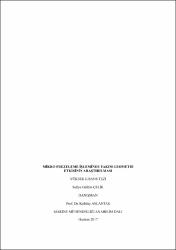| dc.contributor.advisor | Aslantaş, Kubilay | |
| dc.contributor.author | Çelik, Safiye Gülbin | |
| dc.date.accessioned | 2019-05-21T08:44:47Z | |
| dc.date.available | 2019-05-21T08:44:47Z | |
| dc.date.issued | 2017 | |
| dc.identifier.uri | http://hdl.handle.net/11630/5946 | |
| dc.description | In this study, the effects of tool geometry on cutting forces, surface roughness and burr formation were investigated in micro-milling. Three different geometric parameters (helix angle, number of flute and axial rake angle) that may affect the machining performance were used. As workpiece material, Inconel 718 superalloy was used and the experiments were performed under dry cutting conditions. By consecutive cutting processes; changes in cutting forces, burr formation and change of slot geometry were investigated. According to the results obtained; minimum shear forces were obtained at a helix angle of 45°. The helix angle causes of the cutting forces in Fz direction to increase. Increasing number of flute causes in particular, increases the cutting force (Fy) in the feed direction. Increasing cutting distance also increases the environmental wear that is happening around the tool. As a result, cutting forces, surface roughness and burr formation also increase. Values of surface roughness (Ra) were found to be minimum in cutting tools with negative of axial rake angle. Generally, the maximum burr width is found in the direction up milling and is increased by increasing cutting distance. It is possible to say that the helix angle does not have a specific effect on the burr width. The change of axial rake angle from positive to negative effects of on tool life positively while the effect of axial rake angle is minimum on the tool wear. | en_US |
| dc.description.abstract | Bu çalışmada, mikro frezeleme işleminde takım geometrisinin kesme kuvvetleri, yüzey pürüzlülüğü ve çapak oluşumu üzerindeki etkisi araştırılmıştır. İşleme performansını etkileyebilecek üç farklı geometrik parametre (helis açısı, ağız sayısı ve eksenel talaş açısı) dikkate alınmıştır. İş parçası malzemesi olarak, Inconel 718 süper alaşımı kullanılmış olup, deneyler kuru kesme şartları altında gerçekleştirilmiştir. Ardışık kesme işlemleri yapılarak, mikro kanallardaki boyutsal değişim, çapak oluşumu ve kesme kuvvetlerindeki değişim araştırılmıştır. Elde edilen sonuçlara göre; minimum kesme kuvvetleri 45 lik helis açısında elde edilmiştir. Helis açısı özellikle Fz yönündeki kuvvetlerin artmasına neden olmaktadır. Artan ağız sayısı, ise özellikle ilerleme yönündeki kesme kuvvetini (Fy) arttırmaktadır. Artan kesme mesafesiyle, takım çapında meydana gelen çevresel aşınma da artmaktadır. Bunun sonucunda kesme kuvvetleri, yüzey pürüzlülüğü ve çapak oluşumu da artmaktadır. Negatif eksenel talaş açısına sahip kesici takımlarda (Ra) değerleri minimum olarak gerçekleşmiştir. Genellikle maksimum çapak genişliği zıt yönlü frezeleme yönünde elde edilmiştir ve artan kesme mesafesiyle de artmaktadır. Helis açısının, çapak genişliği üzerinde belirleyici bir etkisinin olmadığını söylemek mümkündür. Eksenel talaş açısının takım aşınmasına etkisi çok az olmakla birlikte pozitiften negatife doğru talaş açısının değişimi, takım ömrünü olumlu yönde etkilemiştir. | en_US |
| dc.language.iso | tur | en_US |
| dc.rights | info:eu-repo/semantics/openAccess | en_US |
| dc.subject | Mikro frezeleme, İnconel 718, Takım aşınması, Çapak Oluşumu, Yüzey Pürüzlülüğü, Eksenel Talaş Açısı | en_US |
| dc.title | Mikro Frezeleme İşleminde Takım Geometri Etkisinin Araştırılması | en_US |
| dc.title.alternative | Investıgatıon of Tool Geometry Effect in Mıcro-Mıllıng Process | en_US |
| dc.type | masterThesis | en_US |
| dc.identifier.startpage | 1 | en_US |
| dc.identifier.endpage | 105 | en_US |
| dc.relation.publicationcategory | Tez | en_US |



















